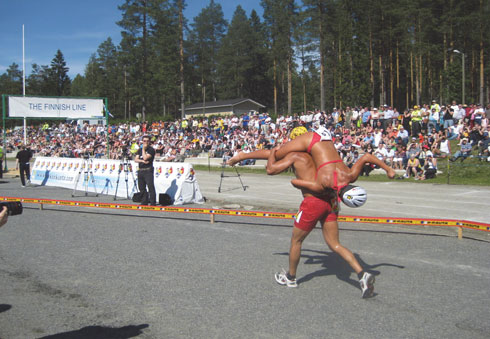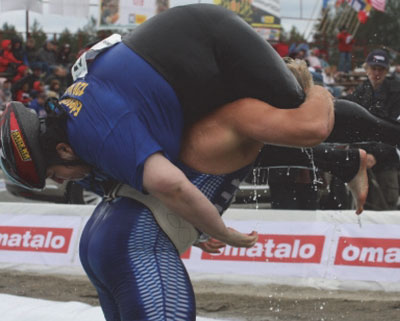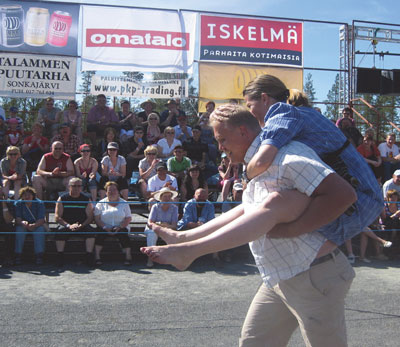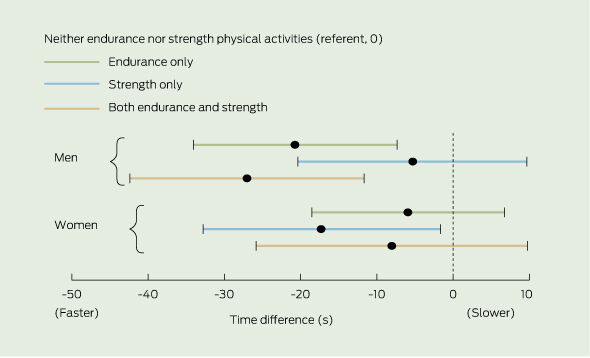Physical activity enhances longevity, but the world’s population is insufficiently active.1 Although the reasons for this are complex, one barrier is that exercise is perceived as boring: a multicountry survey found that 61% of respondents would exercise more if it were fun.2
Another risk factor for premature mortality is the lack of social relationships: a meta-analysis found a 50% increased survival rate among those with stronger social relationships.3
The origin of wife-carrying races lies in the legend of Rosvo-Ronkainen, a Finn living in the 1800s who led men in raiding villages for food and women, carrying the women on their backs as they ran off.4 The Finnish word eukonkanto is colloquially translated as “wife-carrying race” in English; a more accurate translation is “old hag-carrying race”.
The Wife Carrying World Championship began in 1992 at Sonkajärvi, Finland, and has been held annually since then. Contestants are winning couples from wife-carrying competitions in Australia, Estonia, Finland, Germany, Great Britain, Ireland and the United States. The competition4 involves the man running along a 253.5 m track with three obstacles, carrying his “wife”. This “wife” must weigh at least 49 kg, or be weighted to 49 kg. The “wife” need not be your own, but can be “the neighbour’s”.4 As a health bonus, the winner receives the “wife’s” weight in beer, known to improve cardiovascular health when consumed in moderation.5
Here we explore what factors predict better performance in this race.
The mean finishing time for the included couples was 98 s (SD, 34 s). Older men had a slight speed disadvantage of 0.86 s slower for each year older (borderline significance) (Box 1). Female age was unrelated to finishing time, as was race experience (Box 1). Estonians were faster than Finns by 12 s; however, this was not significant, most likely because there were only 11 Estonian couples (Box 1).
Among men, those who engaged in endurance-type physical activities only were significantly faster (by 21 s; P = 0.003) than those who did no endurance- or strength-building activities. Men who carried out both types of activities were significantly faster (by 27 s; P = 0.001) (Box 2); participation in strength-building exercises only was unrelated to race time (P = 0.49) (Box 2). In contrast, among women, strength-building activities (P = 0.03) were significantly associated with faster race times, but endurance activities (P = 0.36) and endurance and strength activities together (P = 0.37) were not (Box 2).
To our knowledge, this is the first study investigating faster performance in a wife-carrying competition. More research needs to be done, since our study was limited by the data available on race entry forms, leading to missing data on many couples and potential bias. While included couples probably represented the field, participants were a self-selected sample. We lacked information on potentially important factors (eg, wife’s body weight). We also lacked data on how best to train for such races (and therefore cannot ascertain whether current physical activity guidelines suffice6) and injury rate. We acknowledge the potential for injury associated with this sport; clearly, this activity is not recommended for everyone. In contrast to the sport of wife carrying, much detailed research is conducted for soccer.7,8 Soccer, immensely popular worldwide, shares similar health-bestowing characteristics — exercise, social relationships (teammate camaraderie), and beer (flung by opposing team fans) — with wife carrying.



- I-Min Lee1
- Sylvia Titze2
- Pekka Oja3
- 1 Division of Preventive Medicine, Harvard Medical School, Boston, Mass, USA.
- 2 Institute of Sport Science, University of Graz, Graz, Austria.
- 3 UKK Institute for Health Promotion Research, Tampere, Finland.
We thank Eero Pitkänen from the municipality of Sonkajärvi, Finland, for generously providing data and photographs; and Christoph Wenger from the Institute of Sport Science, University of Graz, Austria, and Willibald Stronegger from the Institute of Social Medicine and Epidemiology, Medical University of Graz, Austria, for their assistance with data analysis.
No relevant disclosures.
- 1. World Health Organization. The World Health Report 2002: reducing risks, promoting healthy life. Geneva, Switzerland: World Health Organization, 2002.
- 2. Anon. Reebok and Cirque du Soleil launch innovative gym workout for women – JUKARI Fit to Fly [press release]. Canton, Mass: Business Wire 2009. http://www.businesswire. com/news/home/20090225005163/en/Reebok-Cirque-du-Soleil-Launch-Innovative-Gym (accessed Jun 2011).
- 3. Holt-Lunstad J, Smith TB, Layton JB. Social relationships and mortality risk: a meta-analytic review. PLoS Med 2010; 7: e1000316.
- 4. Wife Carrying World Championships. http://www.eukonkanto.fi/en (accessed Jun 2011).
- 5. Kloner RA, Rezkalla SH. To drink or not to drink? That is the question. Circulation 2007; 116: 1306-1317.
- 6. US Department of Health and Human Services. Physical Activity Guidelines Advisory Committee report, 2008. http://www.health. gov/paguidelines/ (accessed Oct 2011).
- 7. Brink MS, Nederhof E, Visscher C, et al. Monitoring load, recovery, and performance in young elite soccer players. J Strength Cond Res 2010; 24: 597-603.
- 8. Mujika I, Santisteban J, Castagna C. In-season effect of short-term sprint and power training programs on elite junior soccer players. J Strength Cond Res 2009; 23: 2581-2587.






Abstract
Objectives: To highlight a fun activity — the sport of wife carrying — and to investigate factors associated with better performance.
Design, setting and participants: Cross-sectional study based in Sonkajärvi, Finland (venue of the annual Wife Carrying World Championship race), of 172 couples participating in wife-carrying races, 1992–2010.
Main outcome measure: Race finishing time.
Results: The mean age for male participants was 32.6 (SD, 8.7) years and for female participants, 30.5 (SD, 9.2) years. The mean finishing time was 98 s. Finish times tended to be somewhat slower as the age of the male partner increased (P = 0.06), but not as the female partner’s age increased (P = 0.89). Race experience was not associated with faster times (P = 0.88). Estonians were almost 12 s faster than other nationalities, although this was not statistically significant (P = 0.25), probably due to the small number of Estonians. Men who engaged in endurance-type physical activities as hobbies (P = 0.003), or in both endurance- and strength-building activities (P = 0.001), were significantly faster than those who did neither. Among women, strength-building (P = 0.03) but not endurance-type (P = 0.36) physical activities were significantly associated with faster race times.
Conclusions: Wife carrying can be a novel option for increasing physical activity levels, which improve health. Although some key data were unavailable, such as wife’s body weight, and injury rates, this study identified several factors associated with better performance in this sport.